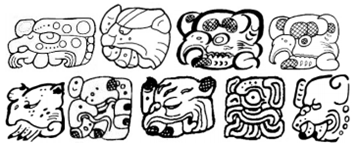![]()

![]()
![]()
K&H.p59.#6.1 K&L.p16.#7 TOK.p26.r3.c3 BMM9.p19.r5.c3 = BMM9.p19.r5.c3
MUWAN MUWAN MUWAAN MUWAN
![]()


JM.p176.#1 = K&H.p59.#6.3 JM.176.#2 MHD.BT2.1&2&3
MUWAN:na MUWAN MUWAN:ni MUWAHN
![]()
![]()
Martin-AMP.p397.pdfp421.r5.c3 Graham?
YAX Lintel 46 I1
K’UH{ul}.<MUWAAN:AJAW> K’UH{ul}.<<[MUWAAN?]AJAW>:wa>
· The month name is the same as the animal.
· Jasaw Chan K’awiil’s burial has ceramic plates which were decorated with the muwaan-bird feathers around the plate.
· MHD transliterates BT2 as MUWAHN (no distinction in 3-character code nor in the transliteration between the bird of prey and the haab month name). However:
o “bllogosyll contains muwan” yields 221 hits.
o “bllogosyll contains muwan” and “blengl contains muwan” yields 114 hits (the month name).
o “bllogosyll contains muwan” and “blengl contains muwahn” yields 67 hits (as part of a personal name/title).
o “bllogosyll contains muwan” and “blengl does not contain muwan” and “blengl does not contain muwahn” yields 10 hits (miscellaneous uncertain items).
· The MHD Catalog has a note under BT2.1: Usually represents supernatural bird of prey, sometimes with another bird in its mouth.
· MUWAAN is distinguished from (the bird-head variant of) o and all other bird heads by the fact that it has one or more feathers in its mouth, i.e. the muwaan is a predatory bird which eats other birds (reference – see the article on owls not found in modern Maya languages).
· Do not confuse MUWAAN with the bird head variant of (y)AL. MUWAAN has one or more feathers in the mouth of the larger bird-head main sign while (y)AL has the small head of a bird in the mouth of the larger bird-head main sign. The baby bird’s head in (y)AL is meant to portray a young chick of the parent bird, hence indicating the parental relationship. In contrast, the feathers in the mouth in MUWAAN are of a smaller bird having been eaten. The example from TOK.p26.r3.c3 even has the end of the leg of the small bird sticking out on the right-hand side!
· It is also an EG of Yaxchilan, but quite a rare one.
o Bíró-EGiCMI.p146.pdfp24.para5: There are also indications that Yaxchilan had its own sub-divisions with different toponyms. As Stuart pointed out, there is a third emblem glyph connected to one ruler of the city (Itzamnaj B’ahlam II) which can be read as k’uhul muwan ajaw also mentioned on an unprovenanced hieroglyphic stairway block possibly coming from El Chorro (Stuart 2007a: 39). On Yaxchilan Stela 4, a Muwan bird is topped with a Pa’chan glyph which probably indicates a specific place within Yaxchilan (Stuart 2007a: 4).
o YAX Lintel 46 I1 is part of a line of inset text H1-J1, consisting of smaller and less deeply incised glyphs: yu.<xu+lu> <tz’i:ba>.<CHAAK:ki> <ya na:bi:li>.<ho:ma:ma> CHAAK:ki K’UH{ul}:<[MUWAAN?]AJAW:wa> ba{ah}.<ka:ba> è yuxul Tz’ihbal Chaak yanaab Homam Chaak, K’uhul Muwaan? Ajaw, Baah Kab:
§ The issue here is that the inset text H1-J1 gives the name and political allegiance of the carver.
§ If I1 is read as just k’uhul ajaw, then this leads to the unusual situation of an EG without a polity / toponym name. This is a little odd, so the question arises whether there might be a polity or toponym infixed into or conflated with the main sign of I1b (which is undoubtedly the “vulture” variant of AJAW).
§ The element emerging from the mouth and going to the right could conceivably be argued to be a feather. If so, then consideration should be given to the possibility that the main sign of I1b might actually be a conflation of (the third and quite rare EG of YAX) – MUWAAN – with the AJAW main sign, written as the “bird-head” ajaw.
§ This leads to the possibility that I1 is actually K’UH{ul}.<<MUWAAN+AJAW>:wa> è k’uhul muwaan? ajaw, hence producing a glyph for the toponym/polity at this point in the inscription.

JM.p175.#4 = K&H.p59.#6.2
mu:wa:ni mu:wa:ni